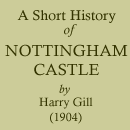< Previous | Contents | Next >
Nottingham Castle.
“WHAT a different world it was before the wars! What strange old world customs and thoughts and stories vanished like phantoms when the war trumpets sounded, and great houses and proud names and dominions and manors and stately woods crumbled into dust.” So spake “John Inglesant” concerning the Civil War of the 17th Century, and his words are appropriate to the beginning of this narrative, for when the conflict began Nottingham possessed one of the finest and most important Castles in the kingdom, whereon the King first unfurled his standard of war, and soon after the conflict was ended the grand old structure was almost entirely swept away.
Anyone visiting the Castle to-day will see the Ducal Residence that rose from the ruins (now converted into an Art Museum), but of the Mediaeval Castle that once dominated the town, and formed such an important and interesting feature, with its examples of the various styles of military architecture that prevailed from the time of the Conquest to the Revolution, no trace remains, excepting a portion of the outer barbican of the time of Edward II. (still used as the entrance), a portion of the walls of the outer ballium between the entrance and Brewhouse Yard, and the base of a tower known as “ Richard’s Tower” just outside the boundary wall, and only seen from the garden of the residence of Mr. Dobson in Castle Grove.
But although the fabric has passed away from sight, the spot whereon so many fateful incidents in our national history were enacted will always command our veneration and interest.
In the old days, when fighting was the chief occupation, the position must always have been an attractive one. A precipitous cliff of New Red Sandstone, rising 130 feet sheer out of the river valley, offered opportunities for a stronghold that could not be overlooked; and this, in conjunction with a navigable river like the Trent giving facility for easy transit to and from the east coast and the Continent, marked the place out from the earliest times as one of great importance.
If we go back into the dim and shadowy past, we find that as long ago as the 8th Century a “strong tower” crowned the summit of the rock; and although no remains of importance have been found in the immediate vicinity, we may infer that the Romans once occupied the position from the fact that in old documents one portion is referred to as “Caesar’s Tower.”
These early structures were not “castles” in our modern sense of the word, but consisted chiefly of defensive earthworks and ditches, with a wooden, house or tower in the centre, surrounded by a stockade, to be used not as a dwelling, but solely for military purposes in times of danger.
There is no mention of Nottingham Castle in Doomsday Book, but this of course is no proof that it did not exist; it may be that when the survey was made the Castle was in course of re-erection, for we learn that when William the Conqueror was on his way to quell the rising at York in 1068 he met with much opposition from the men of Nottingham. Eventually he brought them into subjection, and seizing the commanding position, he compelled them by force to assist him in building thereon a castle “in a style that was unknown before.” It was left in charge of his natural son William Peveril, together with many manors and lands in the neighbourhood.
It is probable that the course of the river Leen was diverted when this castle was built, and made to flow in an easterly direction from Lenton by the base of the rock in order to form an additional means of defence as well as to supply the garrison with water and with motive power for the castle mills. There are indications that the natural course of the river was continued in a southward direction from Lenton, joining the Trent just opposite to Wilford Church, and this is further confirmed by an extract from the “Perambulation of Sherwood Forest” made in the 16th year of Henry III.: “The boundaries of the Forest came down, according to the course of the Leen, to Lenton, and from thence as the same water was wont of old time to run into the waters of Trent.”
NOTE.—The river has been again diverted in recent years, and the Lenton Boulevard constructed above the river bed.
William Peveril became the first Governor of the Castle of whom we have any record, and from his time onward, all through the feudal ages, it grew in importance, being enlarged from time to time by kings and nobles, and it became -the scene of a long succession of stirring conflicts and romantic incidents.
